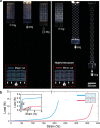Tunable Mechanical Metamaterials through Hybrid Kirigami Structures
- PMID: 29467413
- PMCID: PMC5821861
- DOI: 10.1038/s41598-018-21479-7
Tunable Mechanical Metamaterials through Hybrid Kirigami Structures
Abstract
Inspired by the art of paper cutting, kirigami provides intriguing tools to create materials with unconventional mechanical and morphological responses. This behavior is appealing in multiple applications such as stretchable electronics and soft robotics and presents a tractable platform to study structure-property relationships in material systems. However, mechanical response is typically controlled through a single or fractal cut type patterned across an entire kirigami sheet, limiting deformation modes and tunability. Here we show how hybrid patterns of major and minor cuts creates new opportunities to introduce boundary conditions and non-prismatic beams to enable highly tunable mechanical responses. This hybrid approach reduces stiffness by a factor of ~30 while increasing ultimate strain by a factor of 2 (up to 750% strain) relative to single incision patterns. We present analytical models and generate general design criteria that is in excellent agreement with experimental data from nanoscopic to macroscopic systems. These hybrid kirigami materials create new opportunities for multifunctional materials and structures, which we demonstrate with stretchable kirigami conductors with nearly constant electrical resistance up to >400% strain and magnetoactive actuators with extremely rapid response (>10,000% strain s-1) and high, repeatable elongation (>300% strain).
Conflict of interest statement
The authors declare no competing interests.
Figures




Similar articles
-
Engineering by Cuts: How Kirigami Principle Enables Unique Mechanical Properties and Functionalities.Adv Sci (Weinh). 2022 Oct 30;10(1):e2204733. doi: 10.1002/advs.202204733. Online ahead of print. Adv Sci (Weinh). 2022. PMID: 36310142 Free PMC article. Review.
-
Multifunctional Two-Dimensional PtSe2-Layer Kirigami Conductors with 2000% Stretchability and Metallic-to-Semiconducting Tunability.Nano Lett. 2019 Nov 13;19(11):7598-7607. doi: 10.1021/acs.nanolett.9b01726. Epub 2019 Jun 20. Nano Lett. 2019. PMID: 31244238
-
Kirigami-Inspired Structures for Smart Adhesion.ACS Appl Mater Interfaces. 2018 Feb 21;10(7):6747-6754. doi: 10.1021/acsami.7b18594. Epub 2018 Feb 7. ACS Appl Mater Interfaces. 2018. PMID: 29359914
-
Highly stretchable graphene kirigami with tunable mechanical properties.Phys Rev E. 2024 Mar;109(3-2):035002. doi: 10.1103/PhysRevE.109.035002. Phys Rev E. 2024. PMID: 38632728
-
Kirigami-Inspired Biodesign for Applications in Healthcare.Adv Mater. 2022 May;34(18):e2109550. doi: 10.1002/adma.202109550. Epub 2022 Mar 13. Adv Mater. 2022. PMID: 35073433 Review.
Cited by
-
Bio-Inspired Active Skins for Surface Morphing.Sci Rep. 2019 Dec 9;9(1):18609. doi: 10.1038/s41598-019-55163-1. Sci Rep. 2019. PMID: 31819136 Free PMC article.
-
Design of Rigidity and Breaking Strain for a Kirigami Structure with Non-Uniform Deformed Regions.Micromachines (Basel). 2019 Jun 14;10(6):395. doi: 10.3390/mi10060395. Micromachines (Basel). 2019. PMID: 31207899 Free PMC article.
-
Design of a Kirigami Structure with a Large Uniform Deformation Region.Micromachines (Basel). 2021 Jan 12;12(1):76. doi: 10.3390/mi12010076. Micromachines (Basel). 2021. PMID: 33445722 Free PMC article.
-
Engineering by Cuts: How Kirigami Principle Enables Unique Mechanical Properties and Functionalities.Adv Sci (Weinh). 2022 Oct 30;10(1):e2204733. doi: 10.1002/advs.202204733. Online ahead of print. Adv Sci (Weinh). 2022. PMID: 36310142 Free PMC article. Review.
-
Implantable Cardiac Kirigami-Inspired Lead-Based Energy Harvester Fabricated by Enhanced Piezoelectric Composite Film.Adv Healthc Mater. 2021 Apr;10(8):e2002100. doi: 10.1002/adhm.202002100. Epub 2021 Jan 12. Adv Healthc Mater. 2021. PMID: 33434407 Free PMC article.
References
-
- Tonazzini, A. et al. Variable Stiffness Fiber with Self-Healing Capability. Adv. Mater. 10142–10148 (2016). - PubMed
Publication types
LinkOut - more resources
Full Text Sources
Other Literature Sources
Molecular Biology Databases

